Make Your Nutrition Fit Your Life and Not the Other Way Around
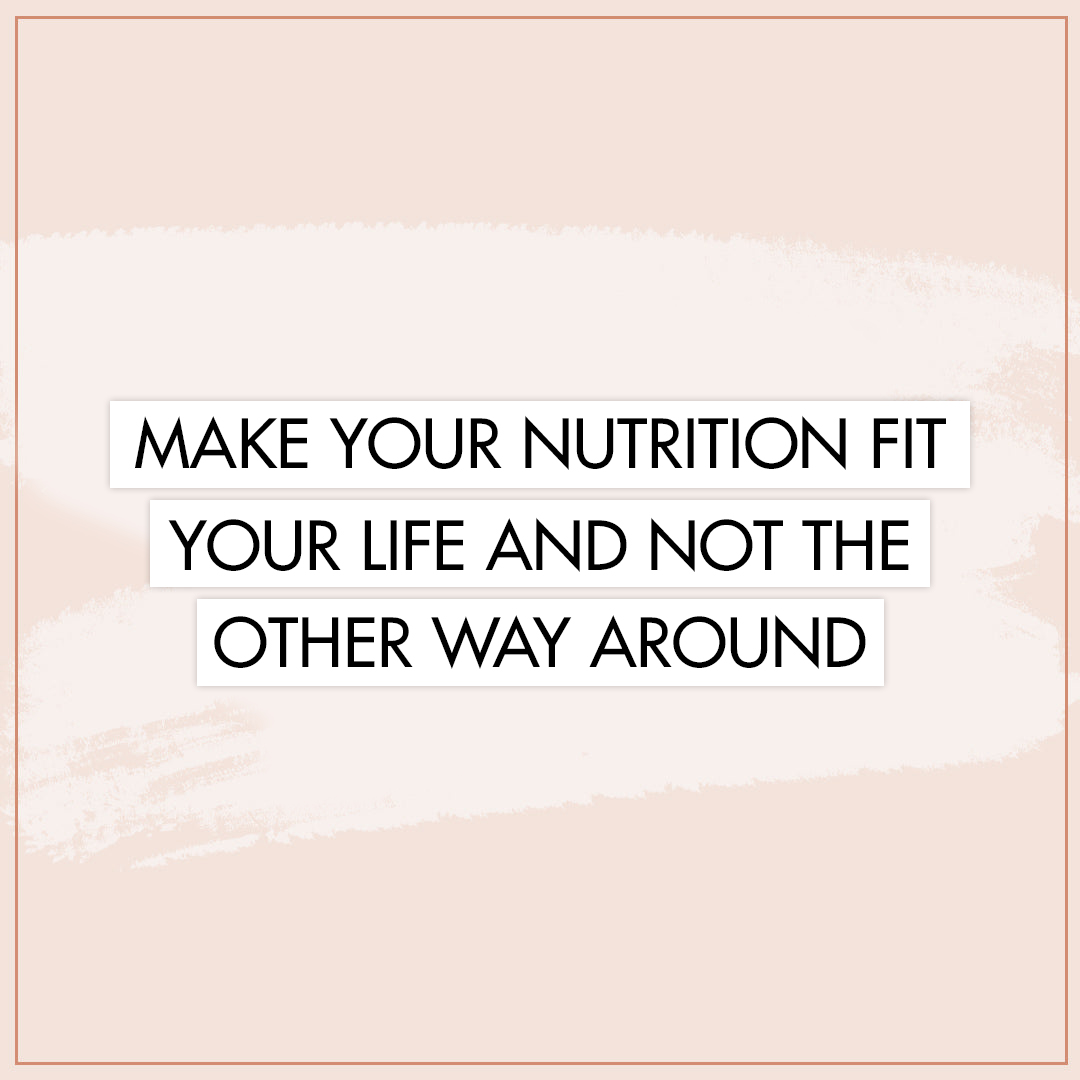
Last summer, I added a new item to my services to complement the release of my e-book, The Beginner’s Guide to Macros. My one-time macro calculation service was provided as an option for individuals who had purchased my product, read through and understand the ins and outs of how to track their nutrition, and wanted a trained eye to get them going with a solid starting point on their nutrition journeys. This, in my opinion, was the perfect pairing, as people could use my e-book as a guide to help them structure their own diets such that they would meet their prescribed macronutrient numbers (grams of protein, carbohydrates, and fats) everyday and also learn to gauge their own progress and make tweaks to their programs on their own. I’m happy to report that I’ve helped hundreds of people with this service since then, and feedback from customers has been overwhelmingly positive.
This has also proved to be an invaluable learning opportunity for me as a training and nutrition coach because with every questionnaire that gets filled out, that’s more data for me. And over the past several months, I’ve been noticing some interesting behavior trends.
Here are just a number of observations I’ve made:
- The majority of individuals struggle to see lasting fat loss progress because the target calories they set for themselves are far too low. This usually stems out of a stubborn desire to be more aggressive with the diet, lack of patience, and the false belief that they can white-knuckle their way through the diet indefinitely. Setting a steep caloric deficit would actually not be much of an issue so long as people could adhere to the program, but most cannot. The stricter the diet, the more deprived you are. The more deprived you are, the higher the chances that you will cave. If and when you do cave, calories typically skyrocket – either for one meal, one weekend, or through several days – and any caloric deficit that was initially created is effectively erased. We find ourselves back at square one.
- Calories aside, women in particular tend to try and be too “good” with their food choices during the day, which backfires by the time evening rolls around. (Please note that I’m putting the word “good” in heavy quotations, as we all know that we don’t qualify foods as good or bad around here. Rather, I’m using the term simply to illustrate the mindset that individuals tend to harbor with their diets: if they’re trying to be “good,” they’re typically avoiding added sugars, extra grease, and any food that may be considered fun.) A full day of feeling deprived leaves them highly vulnerable to overindulge on junk at night, and they end up shooting themselves in the nutritional foot. People are not building enough dietary relief into their nutrition.
- Many over-rely on physical activity (specifically, in the form of steady-state cardio) to try and shed bodyfat and underestimate the importance of proper nutrition. Admittedly, this does work for some individuals, particularly those who genuinely do not mind performing extra exercise in exchanging for keeping more food in their diet. However, most people want to retain (or even gain) muscle mass while shedding body fat, and in order to accomplish this, strength training should be prioritized first above cardio (Ballor et al., 1988). This applies to both men and women.
- “High carbohydrates” is relative, as is “high fats”. I’ve found it especially curious that many folks will tell me that they prefer a higher carb diet, yet report to me that their daily intake is 120 grams. This is not high. In fact, this would be considered a relatively moderate intake for a petite, mostly sedentary woman, and fairly low for more active individuals.
Most who come to me for help come from a background of yo-yo dieting for several years and getting fed up with not seeing results, yet refusing to try and adhere to anything but the strictest diet out of fear. Fear of what? Fear that deviating from anything considered “hardcore” would lead to instant, rapid weight gain. Yet ironically, it is their very extremist behavior that ultimately keeps them stuck in a perpetual cycle of frustration and misery, and this eats away at their quality of life.

Extremes are easy; moderation is hard.
Put another way, extremes are enticing and easier to stick to in the short-term but disastrous in the long-term, while moderation seems boring and ho-hum in the short-term but is far more sustainable.
Restrictive, cookie-cutter programs only work for so long, which means that the results that accompany said regimens tend to be equally as short-lived. So why, then, can’t we do the dang thing?
Because we glorify the difficult.
Because we’re overeager.
Because we’re the generation of instant gratification.
Because of the hot-cold empathy gap, the psychological phenomenon that describes our inability to fully appreciate how difficult or unpleasant a “hot” situation will be when we are currently in a “cold” state (Loewenstein, 2005). In essence, we overestimate our future abilities and underestimate the difficulties of a given scenario, thereby affecting our decision making.
Damn it!
All is not lost, however. It’s entirely possible to take the more moderate approach, even though it can seem scary.
“Have the courage to take things slow,” as Dan John would say.
First, let’s start with what all diets – and by diets I’m referring to the way people eat – have in common. We can all agree that, regardless of how you choose to eat, all healthy diets consist of the following:
- includes a variety of fruits and vegetables
- covers both macronutrient and micronutrient needs
- provides sufficient protein from complete sources
- allows you to maintain quality of life
Now let’s discuss what sets diets apart. The most perfect nutrition program out there isn’t going to work for you if you don’t enjoy it. If you don’t enjoy something, you’re not going to stick to it over the long haul. You’re eventually going to jump ship, and then all the hard work you put in will be for naught.
Don’t try to cram a square peg into a round hole. Rather, find the nutrition puzzle piece that fits nicely into your life, not your favorite fitness model’s.
The hard part is taking the time to figure out your unique nutrition strategy. That could be any one of the following:
- Eat bigger, less frequent meals if you like to feel satiated. You might be better off eliminating snacking altogether if tiny portions do nothing but piss you off and add to your waistline. Eat smaller, more frequent meals if you like to graze throughout the day. You might like this approach if you dislike the sensation of fullness and enjoy having multiple opportunities to chow down.
- Utilize intermittent fasting if you’re not hungry in the morning and don’t care for breakfast. From a lifestyle and practicality standpoint, this could work great for many of you.
- Carb backload (consume the majority of your carbohydrates in the evening) if you crave carbs and calories at night.
- Consume higher carbohydrates on a day-to-day basis if they give you good energy. Consume higher fats on a day-to-day basis if they fill you up. Consume higher carbohydrates on some days and higher fats on other days if you enjoy variety in your diet.
- Eat less during the week when you’re busy with work and have a structured routine. Then on the weekend, you can bump up your energy intake by a few hundred calories and enjoy your social hour. Rig your numbers such that your weekly average still yields a caloric deficit if your goal is fat loss. (This is a strategy that I’ve recently been implementing with more and more clients with great success. They report that this works beautifully for them from a lifestyle standpoint.) Just make sure you’re not bouncing from starvation mode to all-out binges; be more conservative with your fluctuations in food intake.
- Sprinkle in treats, like a few squares of chocolate, into everyday if that helps you stay sane. Alternatively, you can save your indulgences for more isolated occasions, such as Wednesday and Saturday evenings, when you’re out with your friends. Either way is perfectly fine so long as you stay in the moment, keep an eye on food quantity, and then move on with your life.
- Count your macros and adhere to a prescribed set of numbers if you haven’t the slightest grasp of how much you’re consuming and need a little structure for the time being. This might also be appropriate for you if you’re trying to get contest-lean or if your hunger signals are out of whack. Or intuitive eat if you don’t care to spend the time playing with a nutrition app and don’t mind slower progress. Just be mindful of your portion sizes and keep an eye on how your body looks and feels over time.
There are so, so many ways to do this. I can’t tell you which path to take, and neither can anyone else. This is something that you’re going to have figure out on your own. After all, you know yourself best. You know which foods and meal sizes make you feel great and which make you feel crummy.
Pay attention. How are your energy levels after eating a given meal?
The more painless the process feels, the more likely you are to adhere to it over the long-haul. And that’s ultimately what this is all about, isn’t it?

Be careful not to allow your short-term goal override the long-term big picture.
Do you want to see results right away and get to your final destination sooner rather than later? Sure, who doesn’t? That’s completely understandable. But more than that, you should want to maintain those results indefinitely. Adopt a nutrition strategy that you can adhere to with relative ease day in and day out. You should ask yourself if you can stick this particular way of eating a year from now – if yes, then you’re on the right track; if no, then I’d recommend re-thinking your plan.
Have the courage to take things slow.
When we say that we want to drop body fat or build muscle mass, what are we really coveting? It’s the meaning we attach to having a lean physique (and not the body itself) that’s appealing to many of us.
Improved health, sure.
Decreased health care costs, of course.
But when you boil it all down, what we desire is this: a body that allows us to live our happiest, fullest lives.
That’s it. Full stop.
This is impossible if you’re forcing yourself to adhere to a program that provides no relief or enjoyment, that does not take into account your work schedule and eating preferences.
Here are some testimonials from my one-time macro calculation customers. These are people who came to me after making the decision on their own that utilizing a macro-counting approach to achieve their fitness goals was the way to go for them.
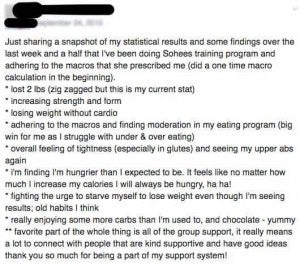

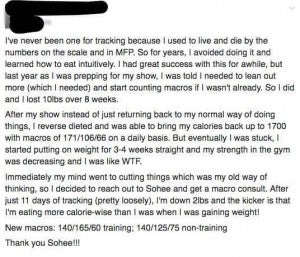
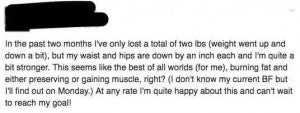
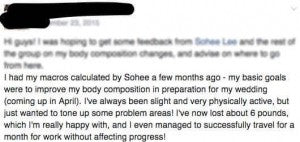

Make your nutrition fit your life and not the other way around.
References
Ballor, Douglas L., et al. “Resistance weight training during caloric restriction enhances lean body weight maintenance.” The American journal of clinical nutrition 47.1 (1988): 19-25.
Loewenstein, George. “Hot-cold empathy gaps and medical decision making.” Health Psychology 24.4S (2005): S49.




